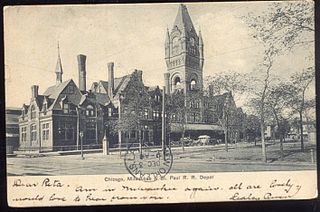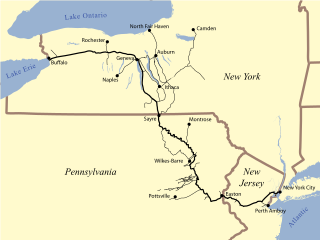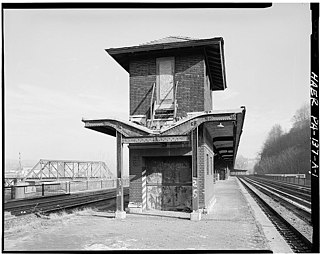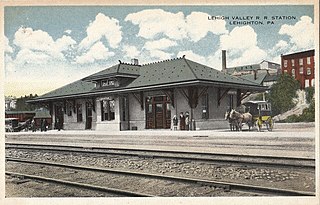The Lehigh Valley Railroad was a railroad in the Northeastern United States built predominantly to haul anthracite coal from the Coal Region in Northeastern Pennsylvania to major consumer markets in Philadelphia, New York City, and elsewhere.

The Lehigh Crane Iron Company, later renamed Crane Iron Company, was a major ironmaking firm in the Lehigh Valley from its founding in 1839 until its sale in 1899. It was based in Catasauqua, Pennsylvania, and was founded by Josiah White and Erskine Hazard, who financed its development through their Lehigh Coal & Navigation Company, which promoted the then-novel technique of smelting iron ore with anthracite coal. This was an important cost and energy savings technique, credited with eliminating the need for either expensive charcoal or coke producing processes and transport costs that proved central to the acceleration of the American industrial revolution.

Everett Street Station, also called Milwaukee Union Station, was a railway station located in downtown Milwaukee, Wisconsin, built by the Chicago, Milwaukee, St. Paul and Pacific Railroad (CMStP&P), commonly known as the Milwaukee Road. The station was located on West Everett Street between North 2nd Street and North 4th Street, and it featured a 140-foot-high clock tower—the largest in America at the time of construction. Designed by E. Townsend Mix in a "modern" functional style, the station combined the Gothic Revival style with elements drawing on Queen Anne and Romanesque Revival styles in an eclectic blend. Walter G. Berg gave a detailed description of the building in Buildings and Structures of American Railroads (1893).

Laurys Station is an unincorporated community and census-designated place (CDP) in North Whitehall Township in Lehigh County, Pennsylvania. It is part of the Lehigh Valley, which had a population of 861,899 and was the 68th-most populous metropolitan area in the U.S. as of the 2020 census. It is located approximately 9 miles (14 km) north of Allentown and about 6 miles (10 km) southeast of Walnutport.
The Hayts Corners, Ovid & Willard Railroad was a 4-mile rural branch line of the Lehigh Valley Railroad running between the connection with the Ithaca branch of the Lehigh Valley at Hayts Corners and Willard Asylum for the Chronic Insane in Seneca County, New York. The history of the Willard Branch was tied with the history of the asylum at Willard.
Locust Valley was a village located in the southeastern corner of Lehigh County, Pennsylvania, United States. The village is located at the southern end of Upper Saucon Township. It is part of the Lehigh Valley, which has a population of 861,899 and is the 68th-most populous metropolitan area in the U.S. as of the 2020 census.

Asa Lansford Foster was a Pennsylvanian geologist, merchant, and coal mine owner. He was also a geologist, mining engineer, and publisher and was one of the pioneers of the anthracite industry. He was a native of Massachusetts but immigrated to Pennsylvania in 1818. Foster married Louisa Trott Chapman.

Historic Sayre Yard, named after the chief engineer and first superintendent of the Lehigh Valley Railroad (LV), was established across the state line in 1876 in Waverly, New York and Sayre, Pennsylvania. The large yard, and the purpose built company town, Sayre, Pennsylvania were founded as part of a planned program of expansion and extension to the young railroad's infrastructure—the yard was but one benchmark on the way to completing the goal of establishing competitive passenger rail service between New York City, as well as cities in Delaware such as Wilmington, cities in central New Jersey such as Trenton, and Eastern Pennsylvania cities including Philadelphia with Chicago and other Great Lakes Cities via Buffalo, New York.

Charles Minot was an American railroad executive at the Erie Railroad, where in 1850 he became Superintendent as successor of James P. Kirkwood, and was succeeded by Daniel McCallum in 1854. After the bankruptcy of the Erie in 1859 he was reinstated as general superintendent of the Erie railroad.

The Lehigh Line is a railroad line in Central New Jersey, Northeastern Pennsylvania, and the Lehigh Valley region of eastern Pennsylvania. It is owned and operated by the Norfolk Southern Railway. The line runs west from the vicinity of the Port of New York and New Jersey in Manville, New Jersey via Conrail's Lehigh Line to the southern end of Wyoming Valley's Coal Region in Lehigh Township, Pennsylvania.
The Beaver Meadow Railroad & Coal Company (BMRC) was chartered April 7, 1830, to build a railroad from the mines near Beaver Meadows, Pennsylvania, beyond Broad Mountain along Beaver Creek to Penn Haven and along the Lehigh River through present-day Jim Thorpe, Pennsylvania to the Lehigh Canal at Parryville, Pennsylvania. The settlement of Beaver Meadows dated to a 1787 land sale to Patrick and Mary Keene, thence to Nathan Beach.

Easton is a defunct train station in Easton, Pennsylvania. It was originally built by the Lehigh Valley Railroad. As of 2017, the structure still exists and was blighted for at least 20 years, since its closing in the 1970s. The city of Easton obtained permission from Norfolk Southern Railway to clean up the property. The location only recently became a focal point for the city with the opening of Interstate 78 in the 1990s.
Allentown was a train station in Allentown, Pennsylvania. It was opened by the Lehigh Valley Railroad in 1890 and closed in 1961. The building was demolished in 1972. The station was located one block west of the Central Railroad of New Jersey's Allentown station.

The Lehigh Valley Terminal was a railroad station in downtown Buffalo, New York. The Lehigh Valley Railroad opened it in 1916, replacing an older station one block east at Scott and Washington streets. Lehigh Valley trains served at the station included the Black Diamond,Maple Leaf and Star. The station handled the Lehigh Valley's passenger traffic in Buffalo until 1955, when it was demolished to make room for the Niagara Thruway (Interstate 190). The Lehigh Valley moved its operations to a smaller station outside the downtown area at Dingens and South Ogden Streets, which served until the end of all Lehigh Valley passenger service in 1961. The terminal also hosted the Erie Railroad's passenger trains from 1935 until 1951, when that railroad ceased serving Buffalo.
Slatington station was a Lehigh Valley Railroad station in Slatington, Pennsylvania, located on the Lehigh Valley main line. The station also served the Lehigh and New England Railroad; the Reading Company at one time had an adjacent station. The Central Railroad of New Jersey had an unconnected station across the Lehigh River in Walnutport, Pennsylvania.

Catasauqua station was a Lehigh Valley Railroad station in Catasauqua, Pennsylvania. It was located on the Lehigh Valley main line.

Lehighton station was a Lehigh Valley Railroad station that was located in Lehighton, Pennsylvania, USA. It was part of the Lehigh Valley main line, and was also the eastern terminus for Hazleton Branch passenger trains, although the branch diverged at Penn Haven Junction, north of Jim Thorpe.

The Jim Thorpe station, also known as the Mauch Chunk station or East Mauch Chunk station, was a Lehigh Valley Railroad station that was located in Jim Thorpe, Pennsylvania.

Flemington Junction station is a defunct Lehigh Valley Railroad station in Flemington Junction, New Jersey. It was located at the junction of the Lehigh Valley's Flemington Branch and Main Line, although the name predated the opening of the branch by eight years.













